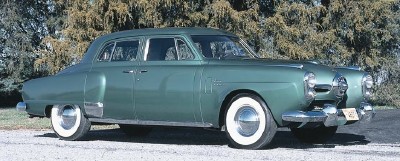Studebaker was proud to be "First by Far With a Postwar Car," but after three years on the market, its vehicles very much needed a distinctive new look for their carried-over bodies. In fact, the 1950-1951 Studebaker origins were as a counterpoint to the post-war car, when celebrated styling consultant Raymond Loewy decided his staff should look to the heavens for inspiration.
 The bullet-nose look unveiled on 1950 models wasn't original, but it was Studebaker's signature. See more pictures of classic cars. |
Perhaps no automaker is more identified with a single design than Studebaker with its 1950-1951 "bullet-nose" cars. The feisty South Bend independent didn't invent the "spinner" front end -- the 1948 Tucker and 1949-1950 Ford used similar themes, as have several European models. Studebaker's styling differed mainly in degree.
Ads called it "The Next Look," implying it would start a trend. It didn't, but that mattered little to company executives, who were content to chalk up sales unmatched in Studebaker's previous 48 years of auto production and in any of the next 16.
Studebaker styling in this period was handled by Raymond Loewy, who was established by the early Thirties as a top-flight industrial designer of everything from lipsticks to locomotives. His first production cars were for Hupmobile: the 1932 second-series line, followed in 1934 by the "AeroÂdynamic," which was influential but not a commercial success.
Loewy signed his first Studebaker contract in 1936; the 1938 models were the first credited to his firm. With dozens of clients, Raymond Loewy Associates employed many designers at its New York headquarters, including Clare Hodgman, Virgil Exner, and others who did most of the actual prewar styling work for Studebaker.
As his business grew, Loewy increasingly became a manager and a tireless self-promoter, taking credit for projects regardless of whether he himself put pen to paper.
In the late Thirties, Exner was sent to set up shop at the Studebaker factory and hit it off with engineering vice president Roy Cole. The two were soon conspiring to undermine Loewy's influence in South Bend. Exner felt his boss didn't give designers enough credit; Cole thought Loewy charged too much for his services.
When Studebaker contracted Loewy Associates to design all-new 1947 models, Exner and Cole worked up their own proposal in secret -- with the advantage of engineering parameters not made available to the "official" Loewy team. It was this design that management ultimately chose and introduced in mid 1946. Studebaker was two years ahead of the competition -- "First by Far With a Postwar Car," as ads blared. To Exner's chagrin, advertising credited Loewy with the new styling.
Loewy promptly fired Exner for his treachery and replaced him with Bob Bourke, Exner's subordinate and friend. Bourke, who made significant contributions to the '47 design, would head Loewy's South Bend studio into 1955, after which Studebaker and Loewy parted company.
People loved the 1947 Studebakers, the little-changed '48s, and the modestly updated '49s. Though the fresh styling concealed mostly prewar mechanical concepts, refinements were made to improve longevity and reliability.
For example, the low-price Champion had arrived in spring 1939 with a lightweight L-head six of 164.3 cubic inches. This went to 169.6 cubic inches and 80 horsepower for 1941-49, then added five horsepower. The costlier Commanders used a larger six dating from StudeÂbaker's 1932 Rockne. By 1949, this engine was up to 245.6 cubic inches and 100 horsepower.
The 1947s did introduce stronger new box- section frames, self-adjusting/self-centering brakes, and "black light" instrument-panel illumination, but retained "planar" front suspension, a Studebaker staple since 1935. This still used a transverse semielliptic leaf spring clamped to the box section of the front cross member, but was modified to lower the center of gravity. Shocks remained Houdaille double-action hydraulics, but the 1947s achieved a smoother ride through more-even weight distribution. A two-piece driveshaft with center universal joint eliminated the rear floor tunnel.
The 1947-1949 models were a great sales success, lifting Studebaker to eighth in the U.S. industry with a market share of 4.12 percent. Production was at record levels. So were corporate profits -- $27.56 million in calendar 1949 alone. Things looked great, and were about to get even better.
The bullet-nose idea had been on Bourke's drawing board since 1940-1941, when he first sketched several elements of the eventual 1950 Studebaker. Chief among them was a protruding nose with flanking pontoon fenders suggesting the front of an airplane.
Some Studebaker managers, doubtless recalling the Thirties, feared buyers might shun anything so radical. But Loewy, ever the master salesman, convinced them to go ahead. "We aimed at the light, fast impression of an airplane ... a feeling of motion and speed," he said later. This daring look drew critical comments, but not from Tom McCahill, then the dean of automotive journalists. "I think the new Studie is the best looking car in its class," he told Mechanix Illustrated readers. Not bad, coming from a guy capable of some pretty scathing remarks.
For more picture-packed articles about great cars, see:
- Muscle Cars
- Sports Cars
- Consumer Guide Automotive
- Consumer Guide Used Car Search
Advertisement


